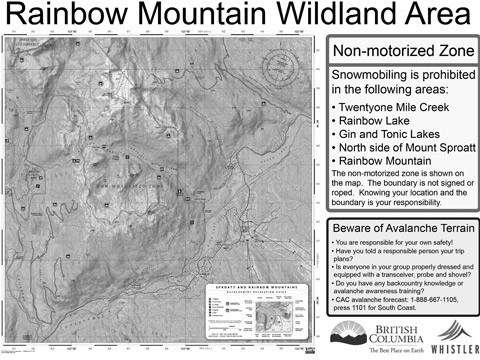One of the action items to come out of the Sea to Sky Land and Resource Management Plan was the creation of new signage to make it clear to backcountry users which areas are closed to motorized recreation - either for environmental reasons, such as the presence of drinking water sources, or because those areas are set aside for non-motorized recreation.
Bryce Leigh, who represented the Federation of Mountain Clubs in a Backcountry Sharing Accord for the area - which was adopted by the LRMP to manage backcountry access - says the signs are the first step to educate the public.
"Under the implementation committee (of the LRMP) it was decided that of all the non-motorized areas, the biggest issue and most contentious is in where there is an issue with drinking water," explained Leigh.
As a result, the west side of Whistler was the first area considered for signage. While there was no budget, the Federation of Mountain Clubs still had $30,000 set aside for their involvement in the Backcountry Sharing Accord, and offered to pay for their installation.
The new signs are already posted at the old Callaghan Forest Service Road across the Callaghan River at another access point from the new road to Whistler Olympic Park, and from the Canadian Snowmobile Adventures. Another sign is going to be placed at a hut where all snowobilers go to meet.
The signs have to be in those areas, Leigh says, because the access to the closed areas is a kilometre wide and more than seven kilometres long.
The new signs make it clear that snowmobiling is prohibited in 21 Mile Creek, Rainbow Lake, Gin and Tonic Lakes, the north side of Sproatt and Rainbow mountains - all areas that provide drinking water to Whistler subdivisions, and that are at risk of contamination as a result of a spill of fuel or fluids. The signs make it clear where non-motorized recreation zones are. These areas are designated to avoid conflicts between backcountry skiers and snowmobiles.
Leigh, a backcountry skier, says he has seen several snowmobiles crossing Rainbow Lake, a source of drinking water, and even came across a broken snowmobile this year that was temporarily abandoned in an area that was closed to motorized vehicles.
The new boundaries are enforced by the Ministry of Forests, but Leigh hopes that most snowmobilers will steer clear of the area once they're aware of it, without the threat of fines.
"You can't blame people for not knowing an area that's off limit or why," he said. "Some locals probably know the reasons, but if you get a group from Chilliwack or somewhere, they're not going to know this information. Let's just see what happens. We put the signs up this season, and if that solves the problem, then great. If not, maybe we'll need to go another step."
Leigh says the Backcountry Sharing Accord came as a result of a series of meetings between stakeholders, including the snowmobile community, the backcountry skiing community, environmental groups and Ministry/Crown representatives. While the presence of a watershed supports their objection to snowmobiles on the west side of Whistler, there are other areas in the LRMP that are reserved for non-motorized recreation.
For Leigh, it's important that snowmobiles recognize that their sport and backcountry skiing are not compatible, and that separate areas have to be maintained to ensure the enjoyment and safety of both parties.
He points to a report called "Recommendations for the Management of Winter Backcountry Recreation in the Lillooet River Drainage and the Sea-to-Sky LRMP Area." In one section it states, "there would have had to be substantive understanding of the following: a recognition that motorized use can have an impact on the ability of non-motorized users to fulfill their recreational experiences in areas where both types of uses take place concurrently - and that non-motorized uses do not have the same potential impact on motorized user experiences."
The Sea to Sky LRMP was approved in 2008,and included the results of a backcountry recreation plan that was created by stakeholders - including representatives from snowmobiling, backcountry skiing and the environment. The plan also involved local governments, government agencies, community stakeholders and First Nations.




